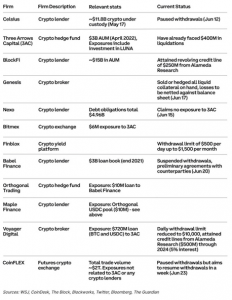With built in pseudo-anonymity, algorithmic regulation technology establishes the possibility of money laundering and identity manipulations, just like the ones that challenge NFT markets. All too often, we overlook the fact that rule of law ensures fairness, equality and above all, provides redressal mechanisms for the same.
——-
EARLIER this year, the largest cryptocurrency exchange, Binance promoted a new cryptocurrency called TerraUSD and its sister token LUNA, collectively called ‘Terra-LUNA’. The token was part of a cohort of coins called ‘stablecoin‘, a type of cryptocurrency that is designed to maintain a pegged value, in this case equivalent to USD 1. However, unlike a reserved stablecoin, which is backed by fiat or gold, “algorithmic” stablecoins like LUNA are pegged with another cryptocurrency, the supply of both being subject to various fluctuations.
In this case, Terra-LUNA claimed to offer stability and the promise of annual returns of almost 20 per cent, allegedly making it low risk and high yield.
As it turned out, Terra-LUNA was neither.
Terra-LUNA collapsed when crypto ‘whales’ or investors started offloading LUNA in large amounts after new tax regulations impacted the market as a whole. In what some call the year’s biggest crypto-Ponzi scheme, the collapse of LUNA was a harbinger of the ongoing market crash. It sent Binance users into a Kafkaesque spiral, with an equivalent of USD 1.6 billion LUNA that was exchanged as part of the original USD 3 million investment, wiped out almost overnight.
Turns out, stablecoins are not necessarily stable.
The beginning of the end: What has led to the collapse?
A Reuters article published on June 2, found that Binance had already facilitated the illicit laundering of at least USD 2.35 billion, including by North Korean hackers, with European pensioners losing their savings. Binance denies all claims.
Binance was also already being investigated by the Securities and Exchange Commission for its Initial Coin Offering held back in 2017. The company is now under heavy investigations because of the Terra-LUNA debacle, with almost every major U.S. financial regulator and countries across the world hot on their heels.
Binance CEO Changpeng Zhao a.k.a. ‘CZ’, one of the richest people from the industry, has recently moved to Dubai.
Binance may still be in a position to retain its employees, unlike other top crypto exchanges which are in the midst of broad layoffs caused by the money crunch. For instance, Coinbase, which laid off 18 per cent of its employees, said in a blogpost published last month:
“We appear to be entering a recession after a 10+ year economic boom. A recession could lead to another crypto winter, and could last for an extended period”. (See Table 1)
More recently, crypto hedge fund Three Arrows Capital has been forced to liquidate leveraged bets on various tokens, and may fail to pay the crypto broker Voyager USD 720 million on loans, for which it is ready to take legal recourse.
The major difficulty is the lack of legal recourse available for an industry that resists regulations. This means that impacted entities cannot rely on the government for a bailout, unlike the banking industry after the 2008 crisis.
Table 1:Summary of past few weeks


Compiled by cryptocurrency researcher David Duong
Also read: Delhi court agrees to look into legality of futures and derivative trading in cryptocurrency
Regulating crypto: what is the way forward?
American entrepreneur Charles Hoskinson, co-founder of blockchain platform Cardano and the decentralized, open-source blockchain Ethereum, has proposed a self-regulatory approach at a U.S. Congressional hearing, suggesting principles over regulatory categorization of technologies that, according to him, do not fit under traditional labels like commodities and securities. He recommends an algorithm-based regulation, for instance where blockchain-based technologies are regulated using blockchain technology, without human intervention unless there is a glitch.
His discomfort with regulatory scrutiny isn’t new or difficult to understand. On the other hand, the much-touted argument against the categorizability of crypto assets begs further scrutiny.
In what some call the year’s biggest crypto-Ponzi scheme, the collapse of LUNA was a harbinger of the ongoing market crash. It sent Binance users into a Kafkaesque spiral, with an equivalent of USD 1.6 billion LUNA that was exchanged as part of the original USD 3 million investment, wiped out almost overnight.
The crypto industry, rife with marketing terms, jargon and buzzwords, rigorously follows the practice of categorizing crypto assets into novel types and broad classes. For instance, the umbrella term ‘cryptocurrency’ includes bitcoin, ‘altcoins‘ such as Ethereum, ‘shitcoins‘ and ‘stablecoins’. It does not include not non-fungible tokens (‘NFTs’), which are based on cryptocurrency but comprise a different category altogether.
On the other hand, while industry insiders attempt to categorize the metaverse as something different from virtual reality and augmented reality, it becomes difficult to accept the classification without a reasonable methodology that is based on some kind of intelligible difference that can be demonstrated logically.
Also read: Why India should start framing a law for the Metaverse
Legal classification follows a similar trajectory as technical categorization. Laws attempt to remain free of industry jargon and marketing terms, which may be disingenuous and agenda-driven. Instead, traditional classification methods are adhered to, unless a novel instance necessitates the notification and definition of new or hybrid classes, including new fraud schemes created by a unique industry.
Law, like science, lends itself to flexibility in order to ensure a realistic representation of phenomena, concepts and objects.
Algorithmic regulation: Futuristic or fictitious?
While the specifics of algorithmic regulation are yet to be detailed by industry members, the limitations of such an approach have been considered in the past. With built in pseudo-anonymity, the technology establishes the possibility of money laundering and identity manipulations, just like the ones that challenge NFT markets.
All too often we overlook the fact that rule of law ensures fairness, equality and above all, provides redressal mechanisms for the same.
Blockchain-based smart contracts have proven to be rigorous in many ways. However, while the technology is sound, the greatest failures of algorithmic regulation may lie in human errors. Algorithms may not show intrinsic bias, but all too often human bias seeps into algorithms. Thus, it is pertinent to consider the full import of using algorithms in place of the written letter of laws, regulations and standards.
Laws attempt to remain free of industry jargon and marketing terms, which may be disingenuous and agenda-driven. Instead, traditional classification methods are adhered to, unless a novel instance necessitates the notification and definition of new or hybrid classes, including new fraud schemes created by a unique industry.
Australian-English lawyer and entrepreneur Thomas Graham, co-founder of Metaphysic.ai that created the viral Tik-Tok DeepTomCruise, explains the problem thus: “Collecting personally identifiable data for complex models ethically with full licensing is incredibly hard today. As a result, best in breed datasets are small and invariably introduce algorithmic bias that systematically misrepresents certain groups of individuals. As the metaverse becomes more important in our social and economic lives, limiting the potential for algorithmic bias is essential.”
Not only does persistent algorithmic bias violate international human rights, like the right to equality and equal treatment before the law, it creates a novel class of discrimination that is built into the legal superstructure without possibility of recourse – unless there is a glitch in the algorithm.
The human element is further complicated by the constant buzz and hype that ubiquitously accompany the rollercoaster ride of crypto markets. This makes it all the more difficult to tell reality from farce.
Even though many regulators and lawmakers do comprehend the notoriously complicated crypto market, it is hard to believe that enough of them would understand the underlying algorithm of a technology-based regulatory mechanism.
The end is only a beginning: How did the crypto market respond?
Crypto lending refers to a type of Decentralized Finance (‘DeFi’) that allows investors to lend their cryptocurrencies to different borrowers in exchange for interest payments or ‘crypto dividends’. Many platforms that specialize in lending crypto also accept stablecoins.
Earlier this year, bullish lenders and exchanges over-leveraged, creating too much debt among borrowers. As markets plummeted, forced selling of Bitcoin and Ethereum drove it into a crash.
Desperate times called for desperate measures. Notably, crypto lender Solana DeFi prevented a heavily indebted whale from tanking the platform during hard times, through timely negotiations, thus protecting its community.
On the other hand, apparently playing the role of the U.S. government that bailed out banks in 2008, FTX crypto exchange has bailed out the lender BlockFi through a USD 250 million revolving credit facility, to protect the ecosystem and customers.
In a surprising turnaround, a May 25 announcement by crypto fintech firm Terraform Labs introduced a new version of the Terra blockchain that does not feature a stablecoin, backed by a new coin, Luna 2.0. The old coins now exist as Luna Classic and TerraClassicUST. Soon after, Binance listed Luna 2.0 as a coin that poses “a higher risk than other tokens.”
In this scenario, too many institutional investors are over-exposed to some of the failing crypto lenders and funds, in which case more selling will ensue, destabilizing the market further. Due to the inherent interconnectivity of the crypto market with fiat currency and traditional financial institutions, this will have wide-ranging consequences, a contagion that can exploit multiple economic actors. Thus, there is an imminent need for sensible regulations to protect the market.
How crypto confirmation bias creeps in
Tech founders and funders aren’t free of confirmation bias and often ignore industry red-flags, as was the case with Binance and Terra-LUNA. Similarly, a sound regulatory approach must reflect the practices and not merely principles of the industry.
Being able to determine the true degree of decentralization and adequately oversee centralized players will require understanding the entire ecosystem with its linkages to both the traditional financial ecosystem as well as illicit market players and criminals, while ignoring the hype around it.
For instance, Web3 and metaverse proponents are both big on the principle of decentralization, enacted through entities like decentralized autonomous organizations (‘DAO’) built on blockchain technology like Ethereum. The DAO’s users and owners get to vote on important decisions through tokens. This includes green lighting a project, administration and management, and exercising investor rights. However, in practice, entrenched natives like blockchain investors, crypto ‘whales’ and large technology companies, including Facebook, are strong centralizing market forces.
As 2022 has already shown us, decentralized projects favoured by centralized institutional investors may fall victim to malicious entities and hackers, losing their value rapidly and crippling the entire market. Being able to determine the true degree of decentralization and adequately oversee centralized players will require understanding the entire ecosystem with its linkages to both the traditional financial ecosystem as well as illicit market players and criminals, while ignoring the hype around it.


In the end, Binance’s approach led to a market collapse, caused by going ahead with Terra-LUNA investment in spite of market scepticism and red-flags. It is desperately hoped by many that the same kind of vulnerability does not become a future trend (although there is not much to be optimistic about that).
The crypto crash caused by whales and scams is reminiscent of the feast shared by the Walrus and The Carpenter in English author Lewis Carroll’s novel ‘Through the looking glass and what Alice found there‘ by Lewis Caroll, which ends with the verses:


“… I weep for you,’ the Walrus said:
I deeply sympathize.’
With sobs and tears he sorted out
Those of the largest size,
Holding his pocket-handkerchief
Before his streaming eyes.
O Oysters,’ said the Carpenter,
You’ve had a pleasant run!
Shall we be trotting home again?’
But answer came there none —
And this was scarcely odd, because
They’d eaten every one.”




